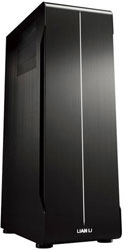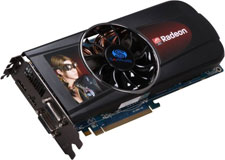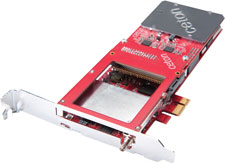Holiday 2010 System Builder's Guide
by AnandTech Staff, edited by Jarred Walton on November 19, 2010 2:00 AM EST- Posted in
- Guides
- Systems
- Holiday 2010
Alan's Ultimate HTPC: Bringing Total Entertainment to the Living Room
Our final build is for those of you who do not like to compromise with your HTPC. Are you tired of hooking up multiple streaming boxes to get all your internet content, NAS for secondary streamers, and another gaming system as well? There are numerous users out there, myself included, that love HTPC as well as gaming. There are many ways to skin the proverbial HTPC cat; this guide is for those of you who want it all in one box on your big screen. There will be sacrifices however, and those come in the size department and in the old pocket book. If you're looking for a small, quiet HTPC that isn't as powerful but doesn't cost an arm and a leg, go look at what Ganesh is pushing.
| Alan's Ultimate HTPC | ||
| Hardware | Component | Price |
| Processor |
Phenom II X6 1090T Black Edition (Thuban 45nm, 3.2GHz, 6x512K L2, 6MB L3, 125W) |
$210 |
| CPU HSF | Noctua NH-D14 | $75 |
| Motherboard | MSI 890FXA-GD70 (AMD 890FX AM3) | $200 |
| Video | Sapphire Radeon HD 5870 1GB (100281-3SR) | $300 |
| GPU HSF | Arctic Cooling Accelero Xtreme | $57 |
| TV Tuner | Ceton InfiniTV4 CableCARD Quad-Tuner | $400 |
| Memory |
G.Skill Ripjaws 2x4GB DDR3-1600 CL9 (F3-12800CL9D-8GBRL) |
$150 |
| OS Drive (SSD) | OCZ Vertex 2 120GB ($20 MIR) | $210 |
| Misc | Icy Dock MB882SP-1S-1B | $20 |
| Hard Drives | 3 x Western Digital Green 2TB (WD20EARS) | $300 |
| Optical Drive | LG UH10LS20 Blu-ray Combo Drive | $85 |
| Case | Lian Li PC-X2000F | $300 |
| Power Supply | Seasonic SS-560KM 560W (80 Plus Gold) ($15 MIR) | $115 |
| Mouse | Razer Mamba | $110 |
| Keyboard | Logitech diNovo Edge | $157 |
| Software | Windows 7 Professional 64-bit (OEM) | $135 |
| Software | Hipporemote Pro | $5 |
| Software | PowerDVD 10 Ultra | $90 |
| Misc | Powermat for iPhone 3GS (PMM-1PB-B2A) | $41 |
| Total System Price | $3015 | |

The first thing to look at for an HTPC is the case, and the most important feature in the case of an HTPC is noise. This is the major problem with multipurpose machines. Gaming cases tend to stay cool but also tend to be noisy and filled with enough LEDs to be mistaken for a flight beacon; after all gamers tend to want to highlight all their high-end hardware. Finding components that will both be cool enough for gaming and quiet enough for a home theater is the key here. A great best of both worlds case is the Lian Li PC-X2000F. At $299 from Newegg as of this writing, the case is pricey, but it currently sports a $200 saving (though that may disappear soon). At that price, I think it is an excellent buy for a home theater/gaming enthusiast.
New to this version is USB 3.0 support and a redesigned case layout. With five 140mm fans, dust filters, and anti vibration solutions, the air-cooling is both highly effective and extremely quiet. Sporting seven HDD bays with the installed back plates for hot-swappable fun, this case has plenty of room for media drives; just make sure your motherboard or RAID card have enough SATA connectors.
Speaking of storage, currently 2TB WD20EARS drives are shipping for $100 and are a great way to expand your media storage capabilities and tend to run on the quiet side of things—no need for a NAS when your HTPC case holds enough traditional HDDs to feed every other device in your home with media! The case is limited to 3.5" drives, but throwing your favorite SSD into an Icy Dock or similar device will allow you to push it right into one of the HDD back plates to get your OS and applications loading at high speed with no noise whatsoever.

For the GPU, I chose AMD because of the bitstreaming support for HD audio codecs. We can argue about performance with the 5870 and 6870, but the 5870 has been around enough that aftermarket cooling solutions are readily available. Add a Noctua cooler to your favorite CPU as well as an Arctic Cooler Accelero on your high-end AMD graphics card for cool and quiet gaming that won't leave you straining to hear during quiet movie scenes. We've also selected a high-efficiency, near-silent 560W power supply from Seasonic to keep everything running; the GPU + CPU combination generally means we need more power than a typical HTPC, but since this is the main feature of the Home Theater/Gaming we went higher end.
At this point, we've taken your NAS or Windows Home Server, HTPC, and gaming PC and combined them into one glorious entertainment system. You'll need help accessing all that media however. Free applications like Boxee and My Movies 3 can help sort local and internet content past what Windows Media Center offers, but pay applications like PowerDVD will integrate well with Media Center and will also play nice with My Movies adding Blu-ray capability into the mix. But there's still more….
The smartphone is one of the best ways I have found to control a Windows-based HTPC. With HippoRemote on your phone and HippoVNC booting on your PC, you can use your smartphone to seamlessly open Windows Media Center, Boxee, Hulu, or myriad other applications. The touchscreen on the phone then transforms into a remote interface designed for the application of your choice. It is a great way to navigate seamlessly between applications that bring you internet or media content without having to browse endless webpages, and there's no need to hack Media Center. The problem is, using your smartphone in this manner depletes the battery at a rapid rate; that's why adding a Powermat on the coffee table will address this problem and charge your smartphone/remote each time you set it down. You'll still want a good wireless mouse as well as a keyboard for gaming. I like the Razer Mamba mouse, while the Logitech Dinovo Mini or Edge are excellent options for the keyboard.

Last but not least, you can add cable TV into your HTPC with a Ceton InfiniTV 4 CableCARD tuner. Although quite expensive and backordered, they bring four simultaneous HD streams into your PC through a single card. Streams can be accessed in other rooms via the Xbox 360, or by adding a network bridge to the tuners (a process still in beta firmware, but it should be available by the time the cards are out of backorder). Or, if you're one of those looking to cut the cable, save $400 and stick with streaming video.
You can see my list of components up top, but play around with what works best for you. I went with an AMD setup to keep the cost slightly lower and chose a single GPU as the system will likely be hooked to an HDTV that will limit the resolution for gaming to 1920x1080. Sadly, the single most expensive item is the CableCARD tuner. But for around $3000, you'll be ripping Blu-rays onto 6TB of storage, controlling your media with your phone, and playing the latest games on your 1080p TV. Enjoy!










112 Comments
View All Comments
JarredWalton - Friday, November 19, 2010 - link
Honestly, the AMD/Intel stuff was in a large part based on editor personal preference. For a budget build, it's hard to match AMD, but ultimately it's just a $40 upgrade to Intel. Some of us really like AMD, some of us really prefer to run Intel. Funny thing is that I'm more of an Intel guy but decided that AMD made the most sense for what I was building, and Vivek definitely wanted to do Intel. Also consider that we didn't want a ton of overlap; if you asked each of us for a system we would REALLY build, no one would put together a dream setup, and likewise few of us would go budget; you'd get all sorts of $700-$1300 builds.The graphics card side was left entirely up to the editors. Some felt the need to list both options and others went with what they felt was "best". But then, there's enough parity in current GPUs that you really can go either way and be fine. So that's pretty much how the process went.
wumpus - Friday, November 19, 2010 - link
Why in the world do you need to make separate Intel/AMD builds to keep the fanboys happy, and why don't you bother to include AMD/Nvidia splits as well?Second, I have to question pairing a GTX580 with a 1920x1200 monitor. While it does let you play crysis2 with absolutely everything turned on, it will be spinning its wheels doing everything else. While trying to build a decent $900 eyefinity* system might require raiding the budget from other components, the end result (5' of monitor instead of a big port hole) is likely superior to any single monitor 1920x1200 (even 24" IPS and a GPU that *never* drops below 60fps).
Finally, with all the worrying over hard drive brands nobody gave a thought to RAID5? You would think in the "ultimate HTPC" system might want to keep data after a drive death, but I guess all that expensive and noisy gear already thrown at it priced [physical] data integrity out the window (an SSD in an HTPC? Junk the software first and put something that works in its place!)
*note that a pair of 460s should not be ignored, and probably fit the price best when trying to match with 3 monitors
JarredWalton - Friday, November 19, 2010 - link
Might want to read Brian's build a bit more carefully:"On every system I've built in recent memory, I've gone with an SSD + RAID array of slow but capacious storage; I think the same is best here. Get four or five 1.5TB or higher HDDs of whatever brand makes you feel warmest inside, toss them in a RAID5 set, and enjoy a crap-ton of storage that's fully redundant. I suppose if you're really feeling ultimate, you could get a RAID card instead of using the ICH10R's software fakeRAID, but it probably isn't critical unless you want to eek out everything you can from those mechanical drives."
Anand has also added his build, with RAID1.
As for 580 + WUXGA, while Crysis is the game everyone mentions, let me just state that Bad Company 2 (and the new Medal of Honor uses the same engine) can be very demanding as well... about as demanding as Crysis in fact. Mafia 2, Metro 2033, and a variety of upcoming and recent titles are also very demanding. I've got a 30" panel with 5850 CrossFire, and I certainly can't max out everything!
ajlueke - Friday, November 19, 2010 - link
I did think about doing RAID 5 in my build. But in all honesty, out of the 3 WD20EARS drives I have purchased and the several 1 TB black editions from WD ,I have never had a single one fail...ever. Certainly I back up my programs and documents as well as anything that cannot be replaced such as pictures and itunes purchases. All the other data on the media drives is already backed up on the physcial discs from which they were ripped, and are now safely stored in my basement. Yes, it would be time consuming to rerip all of the media on a failed drive, but it is also time consuming to rebuild a RAID 5 array. I found the money spent on an extra drive for the storage overhead of a RAID 5 is better spent on cooling solutions to prevent drive failure in the first place. As I have never had a HDD fail in five years of building HTPC systems, I think the policy has worked out fairly well for me. The setup is actually extremely quiet, but certainly not as much some smaller solutions. But adding an SSD definately helps with the noise, as do the green edition WD drives.Jovec - Saturday, November 20, 2010 - link
I agree with the need for data backup, but RAID 1/5 really has no place in 99% of home usage situations. You are better off using a spare drive(s) for a proper backup. RAID provides insurance against hardware failures, but not user error. You are much more likely to suffer an accidental deletion/overwrite/etc than a drive failure.mattgmann - Friday, November 19, 2010 - link
Everything has looked pretty good until this machine.For one, why is a monitor now included? Though I do think it's a good monitor (nice alternative to the dell U2410). But, as a gaming system, why not get 3 24" tn panels for the same price for eyefinity goodness?
Also, what is with the use of all the WD drives? They're good drives, but the samsung f3 and f4 drives are just plain faster and don't cost any more.
Is a sound card really necessary? I would only include it if you're including speakers.
Iketh - Saturday, November 20, 2010 - link
i really appreciated the addition of a monitor in the higher priced builds... the cheaper builds are assumed you'll reuse your current display, just common sense in my book... and then eyefinity? no thanks, unless a monitor with one large curved display exists...i have never and will never build my mid-range or higher gaming PC without a dedicated sound card... the sound clarity is very noticeable for headphones or higher-end speaker systems... but I agree 100% with not a mention of speakers for the systems including a dedicated sound card, please add suggestions!!
Ryan Smith - Tuesday, November 23, 2010 - link
3 TN monitors is certainly an option and I mentioned it in the writeup. However all of these builds are ultimately based at least partially around our preferences, and my preference is for a larger, high quality monitor paired with a single fast GPU, as opposed to many low quality monitors and a dual-GPU configuration.Nataku - Friday, November 19, 2010 - link
Eh... I just thought we'd see a few low~mid range systems with SSDs lolI was going to put together a system like below (im going to wait for sandy bridge instead though)
Zotac H55 w/ wifi
One of the lower cost SSD
probably thermaltake's Element Q for case
cheapest 4GB kit I can find
guess size of HDD does still matter more XD
Nataku - Friday, November 19, 2010 - link
and... stupid of me to forget to include the CPU =.= i was thinking i3 lower end ones